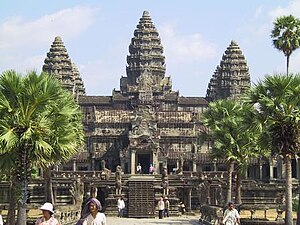 Angkor is one of the most important archaeological sites in South-East Asia. Angkor Archaeological Park contains the magnificent remains of the different capitals of the Khmer Empire, from the 9th to the 15th century. They include the famous Temple of Angkor Wat and, at Angkor Thom, the Bayon Temple with its countless sculptural decorations. (File From UNESCO)
Angkor is one of the most important archaeological sites in South-East Asia. Angkor Archaeological Park contains the magnificent remains of the different capitals of the Khmer Empire, from the 9th to the 15th century. They include the famous Temple of Angkor Wat and, at Angkor Thom, the Bayon Temple with its countless sculptural decorations. (File From UNESCO)
But even UNESCO has inscript it was the World Herigate side and set up a wide-ranging programme to safeguard this symbolic site and its surroundings,They couldn’t stop the bad harmage of weathering. Angkor Wat culture is disappearing under our eyes.
 Since the 1990s, Angkor Wat has seen a resumption of conservation efforts and a massive increase in tourism. The temple is part of the Angkor World Heritage Site, established in 1992, which has provided some funding and has encouraged the Cambodian government to protect the site.[40] The German Apsara Conservation Project (GACP) is working to protect the devatas and other bas-reliefs which decorate the temple from damage. The organisation's survey found that around 20% of the devatas were in very poor condition, mainly because of natural erosion and deterioration of the stone but in part also due to earlier restoration efforts.[41] Other work involves the repair of collapsed sections of the structure, and prevention of further collapse: the west facade of the upper level, for example, has been buttressed by scaffolding since 2002,[42] while a Japanese team completed restoration of the north library of the outer enclosure in 2005.[43] World Monuments Fund began work on the Churning of the Sea of Milk Gallery in 2008.
Since the 1990s, Angkor Wat has seen a resumption of conservation efforts and a massive increase in tourism. The temple is part of the Angkor World Heritage Site, established in 1992, which has provided some funding and has encouraged the Cambodian government to protect the site.[40] The German Apsara Conservation Project (GACP) is working to protect the devatas and other bas-reliefs which decorate the temple from damage. The organisation's survey found that around 20% of the devatas were in very poor condition, mainly because of natural erosion and deterioration of the stone but in part also due to earlier restoration efforts.[41] Other work involves the repair of collapsed sections of the structure, and prevention of further collapse: the west facade of the upper level, for example, has been buttressed by scaffolding since 2002,[42] while a Japanese team completed restoration of the north library of the outer enclosure in 2005.[43] World Monuments Fund began work on the Churning of the Sea of Milk Gallery in 2008.
Angkor Wat has become a major tourist destination. In 2004 and 2005, government figures suggest that, respectively, 561,000 and 677,000 foreign visitors arrived in Siem Reap province, approximately 50% of all foreign tourists in Cambodia for both years.[44] The influx of tourists has so far caused relatively little damage, other than some graffiti; ropes and wooden steps have been introduced to protect the bas-reliefs and floors, respectively. Tourism has also provided some additional funds for maintenance—as of 2000 approximately 28% of ticket revenues across the whole Angkor site was spent on the temples—although most work is carried out by foreign government-sponsored teams rather than by the Cambodian authorities.
Where to stay ?
It’s warm sunny season in December and January at Siem Reap where Angkor Wat sit. And you can find great hostel rate at HotelsCombined,just 28$ one night for a four Star hotel in City center, And you can also find low to 2.1 $ per night’s hostel bed at HostelWorld, And a beautiful small hotel offer breakfast, fruit and bicycle total only 6$ a day!












